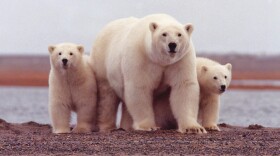We’ve all seen or experienced it – unfortunate wildlife dashes in front of a car at just the wrong time - and its remains splatter across the road. But Danielle Garneau, a wildlife ecologist at SUNY Plattsburgh, says the roadkill we’re likely to see on roads this holiday season can teach us a lot.
She’s using a new smartphone app for citizen scientists.
Admittedly, this is a weird sight – two women standing by the side of the road, smartphones out, peering down at a dead, bloody, and smelly skunk. I balk at the smell. But SUNY Plattsburgh wildlife ecologist Danielle Garneau laughs and takes a closer look.
EpiCollect
"So this guy must’ve gotten hit and flipped over onto the edge here. Our first step is to pull up EpiCollect; we’ll go to the new entry option, and the first thing I like to do is tap my current location, latitude and longitude," she explains.
We take a picture of the dead skunk, lying there motionless. And then we input a lot of data: time of day, the road’s speed limit, season, temperature.
"Precipitation is multiple choice, I don’t think it rained here yesterday so I’m gonna say none. State is New York."
Roadkill as red pushpins
When we finish, all this data gets sent to the project server and the roadkill appears as a red pushpin on a digital map. Now there are over 200 of these little dots. They continue to appear - one by one - as Garneau and a dedicated corps of students, friends and colleagues log the animals that they see by the road.
Roadkill may not be glamorous—but Garneau says these dead critters carry valuable information.
"We’re looking at a fine scale at patterns of animal movement. Maybe we can pick up migratory patterns, maybe we can see a phrenology change. And in the long term if many of these animals are threatened or they’re in a decline the hope would be that we could share this information with people who could make changes," she says.
The program she’s using is called EpiCollect – an open source, data collection app she discovered at a conference last summer.
It’s free, and anybody with a smart phone can use it. Garneau has integrated it into the classes and labs that she teaches.
An afternoon of collecting
Over the course of the afternoon, we log a lot of dead animals. We see rabbit who’s tail is about 20 feet down the road. We see a red squirrel with a deep gash across its back.
We see an almost unrecognizable raccoon - half its body on one side of the road, half on the other.
"Oh man," says Garneau. "This is just a pancake. A pancake with a little tuft of fur."
Some of it’s fresh, and some of it’s been pretty picked over.
"Scavenged, pulled apart, rained on, frozen," Garneau adds.
Richard Crawford, a local contractor, pulls over and asks what we’re doing. He says he keeps an eye out for roadkill too.
"Skunks and raccoons. It's gettin' more prevalent this time of year cause they’re gettin’ too fatten up for the winter," he notes.
I can’t help but get a little philosophical about all the dead animals. Garneau does too.
"We’re embedded in their world and they’re embedded in our world and the boundaries are kinda blurry."
Richard Crawford though, isn’t so sure.
"Keep in mind; it’s the cat or the dog or the squirrel who ran in front of a car at that spur of a moment you can’t stop it fast enough and you can’t control it. My wife sends me through the windshield to let a squirrel go by. There’s no question. I go through the windshield to save the squirrel," he says with a wry smile.
Noticing the wildlife
By the end of the afternoon, my eyes feel sharper and I’m noticing wildlife.
Danielle says that’s what citizen science is all about.
"You can take a photo, use a plug-in and identify that bug you just took a picture or use an app called leaf snap and experts can chime in and tell you what the tree is that you just saw," she says.
People talk a lot about technology cutting us off from nature. But I found that with the road kill project, it’s the opposite. You really engage with the world around you - even if it is a smelly skunk decaying on the side of the road.







